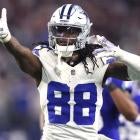
The 2019 NFL Draft class of quarterbacks has two surefire starters (Kyler Murray and Daniel Jones) and one competing for the starting job (Drew Lock) entering the 2022 season. Murray, of course, has been the most successful, but the jury is out on how handsomely he should be paid by the Cardinals as he nears the end of his rookie deal. Some believe they should let him walk.
Jones enters a clear make-or-break season with a new regime with the Giants, and Lock was part of the Russell Wilson deal. He'll battle it out with Geno Smith for Seattle's starting gig.
Let's look back on the 2021 seasons of all three of these quarterbacks and provide outlooks for their 2022 campaigns.
Cardinals QB Kyler Murray
How he's improved
In Year 3, Murray took a step forward in a few key areas with the Cardinals, most notably efficiency as a passer, which obviously is paramount in today's NFL. His 69.2% completion percentage was a career high, as was his 7.9 yards-per-attempt average. Good signs for the former No. 1 overall pick.
After stepping into the NFL and instantly proving to be one of the league's best deep-ball throwers in his first two seasons, Murray got more accurate on deep rips down the field in 2021. After posting a rock-solid 45.3% adjusted completion percentage on throws made at least 20 yards downfield in 2020, that rate improved to 51.3% last season.
Supporting cast
At the time of publication, superstar wideout DeAndre Hopkins is set to serve a six-game suspension to begin the season for a violation of the league's performance-enhancing drug policy. That stings. Murray kept his head above water without Hopkins over the final month of the regular season, but in the embarrassing playoff loss to the eventual Super Bowl champion Rams, Hopkins' absence was palpable. Murray's 40.9 passer rating and 4.03 yards-per-attempt average in that outing were both the lowest of his NFL career. It was ugly.
Likely in the know about the suspension of Hopkins in late April, the Cardinals traded for Murray's favorite target from Oklahoma, Marquise Brown, during the draft. In theory, this should make Murray's environment even more familiar to him than it previously was in Kliff Kingsbury's Air Raid offense.
Improving his weaknesses
Murray still takes too many sacks. Point blank. Period. After Murray's sack-rate plummeted from 8.1% of his dropbacks in his rookie season to 4.6% in 2020, his sack rate increased to 6.1% last season. That's not an absurdly high number, and Murray's scrambling brilliance counteracts some of the instances in which he's tackled behind the line. Or did it last season? His yards-per-rush average sunk to 4.8 last year from 6.2.
Murray also has to boost his effectiveness on short passes, the layups. Consider this: For as game-changing of a deep-ball thrower as Murray has proven to be in the NFL, 59.2% of his attempts in 2021 were either behind the line of scrimmage or up to nine yards beyond it. His rating on throws behind the line (82.1) ranked 30th out of 31 qualifiers. And on throws up to nine yards past the line, Murray's adjusted completion percentage (81%) was the 24th best in football. The splash plays make the highlight package. Sharpening his skills on the easier throws would work wonders for his development.
Strengthening his strengths
Kyler's got to let it rip. And rip often. That's his style. And he's good at it. If anything, Kingsbury should dial up more shot plays for his quarterback, particularly when Hopkins and Brown are on the field together. Let's not forget about Rondale Moore, the team's second-round pick in 2021. The dude glides on the field and ran a 4.32-second 40-yard dash at Purdue's pro day last year.
If I'm Kingsbury, I'm certainly preaching to Murray about tightening his accuracy on short throws while amplifying the frequency at which he's launching it deep on Sundays.
Season outlook
For the first third of 2022, Murray won't throw to the one elite weapon the likes of Patrick Mahomes, Josh Allen, Justin Herbert, and Derek Carr have. Still, he's shown he can survive without Hopkins.
Truth be told, Murray's looming contract issue getting resolved before the season would alleviate significant, unnecessary pressure from his shoulders. It's challenging to label a quarterback as legitimately good when his team has experienced no playoff success in three years with him in the shotgun. But when distilling what Murray does individually from Arizona's win-loss record during his tenure as the starter -- because the latter is not solely dependent on quarterback play, of course -- the Cardinals front office should do whatever possible to keep him around.
Murray will likely hover right around the middle of the tier right below the elite group of quarterbacks in today's NFL in 2022. Is that good enough for a Cardinals playoff push and win in the postseason? Enough to earn Murray a mega extension? He should certainly get the latter.
Giants QB Daniel Jones
How he's improved
Jones began his career with a severe ball-security problem. He led the league with 18 fumbles as a rookie and threw 18 adjusted interceptions -- which are explained by Football Outsiders here -- which were the seventh-most in the NFL that season. While he again led the league in fumbles in 2020, his number dropped to 11, and his 12 adjusted interceptions demonstrated an improvement in that category, too.
Last season, his interception rate sank below 2.0% for the first time in his pro career, and he fumbled once every 58 dropbacks after doing so every 51 dropbacks in 2020 and every 28 dropbacks as a rookie!
Supporting cast
It's taken a while, but Jones finally looks to have a quality cast of characters around him. We can't fault former GM Dave Gettleman for trying, as New York's skill-position acquisitions and Saquon Barkley were seemingly always injured. Not holding back here -- the offensive line has been an abomination for the vast majority of Jones career with the Giants to date, and new GM Joe Schoen wasn't having that anymore.
He made free-agent signings up front and selected three blockers in the draft, including Evan Neal in Round 1. Message sent. In the second round, New York added Kentucky's Wan'Dale Robinson. The small wideout is freaky elusive and should become a YAC weapon for Jones. If everyone can stay even relatively healthy, Jones has plenty of talent out wide and in front of him.
Improving his weaknesses
Clean-pocket play is more predictive than anything else for a quarterback, and Jones has yet to post an even average, much less an upper-echelon season when the protection around him isn't leaky. If Year 4 is the magical season for the former Duke star, he needs to throw with more accuracy and make better decisions when his pockets are clean.
Strengthening his strengths
Entering Year 4, there is not one area of Jones' game that's been a clear-cut strength. Maybe his deceptive running ability? Probably that, yeah. But I won't go as far to suggest Jones should be utilized in designed-run concepts in Brian Daboll's attack on a regular basis.
Season outlook
By now, I feel like I know what Jones will give the Giants and who he is as an NFL quarterback. He's more competent than many naysayers -- including myself -- believed he'd be when he entered the league. And the environment around him is better. The coaching will be the best he's had. He's also in a contract year. Jones will be a touch better. But not enough for the Giants to consider extending him while simultaneously passing on a young, super-talented passer in next year's draft.

Pick Six Newsletter
Crafted By The Best NFL Experts
Get the day's big stories + fun stuff you love like mock drafts, picks and power rankings.
Thanks for signing up!
Keep an eye on your inbox.
Sorry!
There was an error processing your subscription.
Seahawks QB Drew Lock
How he's improved
After leading the league with 15 interceptions -- which featured a 3.6% interception rate -- Lock's interception rate dipped to 1.8% on his 111 attempts last season. Sample size needs to be considered here, of course. Other than that, Lock did not improve in 2021, nor did he the year before.
Supporting cast
Now in Seattle, Lock will have DK Metcalf and Tyler Lockett, one of the league's more underrated, complementary receiver duos. Beyond that, the Seahawks are grasping at straws at receiver, hoping one of the likes of 2021 second-round pick D'Wayne Eskridge, 2020 sixth-rounder Freddie Swain or 2022 seventh-rounders Dareke Young or Bo Melton emerge as legitimate threats.
There's a good chance the offensive line is one of the most porous in football, unless top-10 pick Charles Cross pass protects like he did at Mississippi State last season. That's concerning.
Improving his weaknesses
After not being pressured often in college, Lock wasn't ready to face a barrage of consistent pressure in the NFL, and the Broncos never truly afforded him a quality blocking unit. Beyond that, he was an odd fit with the offenses in Denver, schemes that asked him to mostly get it out quickly and accurately underneath.
Even if the Seahawks allow Lock to let it rip downfield more frequently, he must significantly better his decision-making skills and ball placement on underneath throws. Even those at the intermediate level. His adjusted completion percentage on throws made between 10 and 19 yards was just 55%, which tied for dead last among 49 qualifying quarterbacks.
Strengthening his strengths
Let Lock cook. Ok, so he's not Russell Wilson 2.0 ready to be unleashed, but as a draft analyst, I vividly remember Lock operating a wide open, Air Raid offense in his junior season of 2017 and, well, he threw 44 touchdowns to just 13 picks at a respectable 9.5 yards-per-attempt average.
Then his senior-year offensive coordinator tried to bolster his completion percentage by adding considerably more short throws, and the yards-per-attempt figure actually dipped at the cost of a higher completion rate. Not worth it.
In Seattle, new offensive coordinator Shane Waldron should certainly implement many of the concepts he learned under Sean McVay in Los Angeles -- many of which will get Lock, a stellar athlete, on the move -- but the deep shots have to be taken and taken often. That's when Lock is truly comfortable and at his best.
Season outlook
This is me going on a hunch more than anything else, and it's because I believe in Lock's natural talent. After his season in Seattle, he'll re-enter the conversation as those who are capable -- not tremendous -- starters.
The weakness of Seattle's offensive line will give him fits at times, but Metcalf and Lockett's downfield prowess, along with his former Broncos teammate Noah Fant -- a fast, athletic tight end who arrived in Seattle in the trade as well -- will help Lock improve in 2022.























